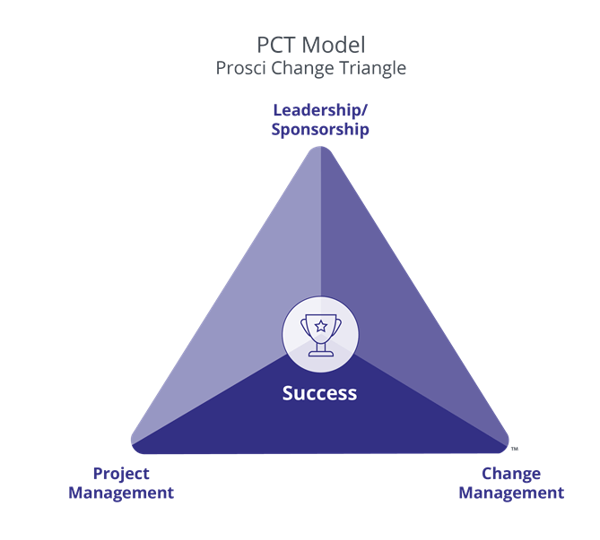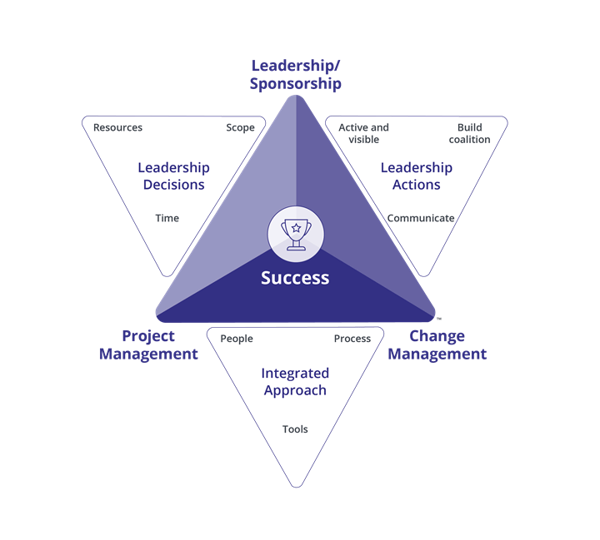How Executives Support the Prosci Change Triangle (PCT) Model

2 Mins
Updated: August 7, 2024
Published: June 2, 2021

The Prosci Change Triangle (PCT) Model is a simple but powerful framework that shows the four critical aspects of any successful change effort and how they interrelate. Expanding the model shows how leadership decisions and actions influence project success.

Leadership Role in Successful Change
The PCT Model is a simple but powerful framework that shows the four critical aspects of any successful change effort: success, leadership/sponsorship, project management and change management. The expanded model builds on the Prosci Change Triangle (PCT) Model by illustrating the interaction between leadership and the other two elements of successful projects.
Success is the reason for your change, and it sits at the center of the model to signify that all of the other aspects support it. The sides of the triangle depict the unique relationships between leadership/sponsorship and project management, between leadership/sponsorship and change management, and between project management and change management.
Leaders play a key role in supporting the project management and change management corners of the model. The expanded Prosci Change Triangle (PCT) Model shows that:
- the connection between leadership and project management is related to decisions made by leaders
- the connection between leadership and change management is tied to the actions of the senior leaders
Before your leaders and sponsors can support project management and change management efforts, they must understand their role and its importance to success.
At the onset of a new project, the executive sponsor should ask:
- What is our project management readiness?
- What is our change management readiness?
- Am I ready to sponsor this change?

These steps are important to ensure that the four aspects of the Prosci Change Triangle (PCT) Model are in place before getting started.
Project management roles
Key roles on the project-side of the change (project management):
- Define the scope, resources and schedule that are needed to align with the business strategy and objectives.
- Resolve project issues by balancing scope, resources and project dates.
- Help set priorities between this project and competing projects or day-to-day operational commitments.
On the project side, leadership is central in defining what will be changed and how it will be changed. This is why the connection between leadership and project management is referred to as executive decisions in the Prosci Change Triangle (PCT). The first requirement on the project-side is to clearly define what is changing in the organization. While executives typically outline some of the dimensions like scope and schedule when they charter a project, it is equally important for them to monitor and balance the time-scope-resource tradeoff on the project.
Change management roles
Key roles leaders play on the people-side of the change (change management):
- Actively and visibly participate throughout the entire change process, stay engaged with the project team, and collect feedback from employees using ADKAR Assessments.
- Build a sponsorship coalition that reinforces the awareness message at all levels. Enable peers, direct reports and managers to communicate the reasons for change to their employees such that a consistent message finds its way throughout the organization.
- Communicate support directly with employees, share why the change is happening, share the risks of not changing, and align the change with the overall direction of the business. Repeat these messages through multiple communication channels including face-to-face interactions.
Senior leaders play a central role in making change successful. In all of Prosci's Best Practices in Change Management benchmarking studies, participants cited the role of the sponsor as the number one contributor to success. In most of these studies, the role of the senior leader was cited by a three-to-one margin over any other success factor.
Help Leaders Engage in Change
One of the biggest issues related to the executive actions on the change management side is that senior leaders don't know what good sponsorship looks like in concrete terms. Some understand conceptually without knowing what actions they need to take. It is the responsibility of the change management practitioner to educate and coach senior leaders on how to fulfill the ABCs of Sponsorship, and provide them with checklists and other support. Only then will your leaders feel prepared and equipped to successfully execute their roles during change.



